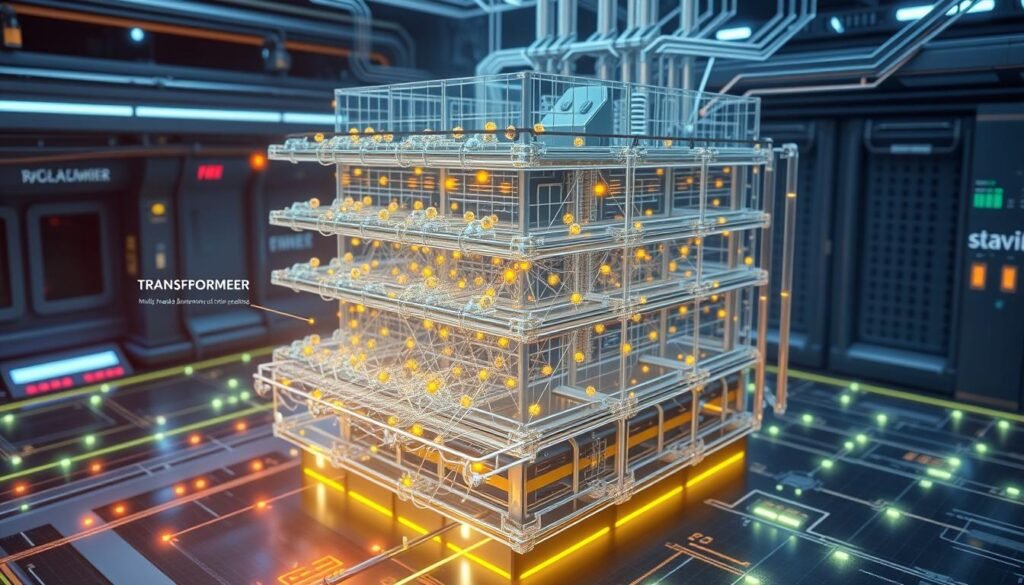In the fast-changing world of artificial intelligence (AI), you’ve probably heard about large language models (LLMs). They are great at understanding and creating natural language. But, LLMs are just a part of machine learning (ML). Knowing the differences between LLMs and traditional ML is key to choosing the right one for your needs.

LLMs, like GPT-4, are top at understanding and making text. They do well in tasks like figuring out how people feel about something, classifying text, translating languages, and creating content. On the other hand, traditional ML models are great for tasks with structured data, like predicting financial trends or analyzing health data.
Even though LLMs are getting a lot of attention for their language skills, traditional ML models are still very useful. They are especially good for specific problems where they can be very precise and efficient. Whether to use LLMs or traditional ML depends on your project’s needs, the type of data you have, and what you want to achieve.
Key Takeaways
- LLMs specialize in natural language processing and generation, while traditional ML models excel in structured data tasks.
- LLMs can exhibit emergent capabilities not present in smaller models, expanding their range of applications.
- Traditional ML models are generally less expensive to host and maintain, offering a more cost-effective AI solution.
- Integrating LLMs with traditional ML can enhance the handling of both textual and numerical data, broadening problem-solving capabilities.
- Businesses can leverage the combination of LLMs and traditional ML to create innovative, efficient, and reliable AI solutions.
Understanding the Evolution of Machine Learning Models
The field of machine learning has changed a lot over time. It started with simple algorithms and now we have powerful neural networks and deep learning. These changes have led to the creation of Large Language Models (LLMs), which have changed how we handle natural language processing.
From Simple Algorithms to Neural Networks
At first, machine learning used basic algorithms like linear regression and decision trees. These models were not very good because they needed a lot of work to get ready. But, the 1980s brought a big change with neural networks and the backpropagation algorithm.
The Rise of Deep Learning Technologies
Deep learning came along with its complex neural networks. It opened up new areas like computer vision and natural language processing. These models could learn from data on their own, making manual work less necessary. Big datasets and fast GPUs helped make these advanced models possible.
The Emergence of Large Language Models
Recently, Large Language Models (LLMs) like BERT and GPT-3 have made a big splash. They have billions of parameters and can understand and create text like humans. The success of LLMs is thanks to transformer architectures, which were introduced in 2017.
The journey of machine learning from simple to complex models has been fueled by better hardware, more data, and new algorithms. These models are changing artificial intelligence and affecting many industries and uses.
Core Components of Traditional Machine Learning
Traditional machine learning uses many techniques, like supervised, unsupervised, and reinforcement learning. These models are great at working with structured data. They are used in many fields, including finance, healthcare, and manufacturing.
Supervised Learning: This includes algorithms like linear regression and decision trees. They help with tasks like spam detection and image classification. These models get better with time as they learn from labeled data.
Unsupervised Learning: This involves techniques like clustering and dimensionality reduction. They help with customer segmentation and finding patterns in data. These models find insights in data without labels.
Reinforcement Learning: This is used in games, robotics, and autonomous driving. Algorithms like Q-learning learn by interacting with their environment. They adjust their actions based on rewards or penalties.
Feature extraction is key in traditional machine learning. It requires creativity and domain knowledge to find the right features. These models are good for places with limited resources because they are easy to understand and efficient.
| Technique | Applications |
|---|---|
| Supervised Learning | Spam detection, image classification, fraud detection |
| Unsupervised Learning | Customer segmentation, anomaly detection, recommendation systems |
| Reinforcement Learning | Game playing, robotics, autonomous driving |
What is the Difference Between LLM and Traditional Machine Learning Models
The world of artificial intelligence has changed a lot lately. Large Language Models (LLMs) have become very popular. They are different from traditional machine learning (ML) models in many ways.
Architecture and Training Methods
LLMs, like OpenAI’s GPT series, use a special architecture called transformers. This lets them understand and create text that sounds like it was written by a human. Traditional ML models are simpler and focus on specific areas, needing less data and manual work.
Data Requirements and Processing
Training LLMs needs huge amounts of data, often billions of words. This is a big difference from traditional ML models. They work with smaller datasets and need more manual effort to get useful insights.
Model Complexity and Scalability
LLMs have billions of parameters, making them much more complex and scalable than traditional ML models. This lets them handle many tasks, like generating text and solving problems, without needing to be fine-tuned for each task. Traditional ML models are easier to understand but can’t tackle as many complex tasks.
Choosing between LLMs and traditional ML models depends on the task, resources, and goals. LLMs are great for tasks that involve a lot of language, while traditional ML models are better for specific, specialized tasks. Knowing the strengths and weaknesses of each is key in the world of artificial intelligence.
Key Features of Large Language Models
Large language models (LLMs) are changing the game in artificial intelligence. They have a special design called the transformer architecture. This design lets them understand long sentences and context, making them great at many tasks.
Training these models is key to their success. They learn from huge amounts of text data. This training helps them understand language well, which they can then use for specific tasks.
LLMs are huge, with billions of parameters. This size lets them handle complex language features easily. They can do many tasks well, making them very useful in natural language processing.
| Feature | Description |
|---|---|
| Transformer Architecture | LLMs use the transformer architecture. It has a self-attention mechanism for processing sequences well. |
| Pre-training and Fine-tuning | LLMs are first pre-trained on lots of text data. Then, they are fine-tuned for specific tasks. |
| Massive Scale | LLMs have billions of parameters. This lets them grasp complex language details and adapt to new challenges. |
| Generalization Ability | LLMs can handle many language tasks well. They are versatile and adaptable. |

Model Training and Resource Requirements
Training large language models (LLMs) like GPT-4 needs a lot of resources. They require top-notch GPUs or specialized hardware like tensor processing units (TPUs). This is because they handle a huge amount of work.
These models need billions of data points. This means they need huge datasets that are carefully prepared. This is a big job.
On the other hand, traditional machine learning (ML) models need less powerful hardware. They can run on standard CPUs. These models need less data but require more work to get the most out of it.
The time and cost to train LLMs are big issues. They need a lot of power and data, making the process slow and expensive. The need for special hardware, long training times, and lots of data add to the costs.
Hardware and Computational Needs
- LLMs need strong computational resources, like high-end GPUs or TPUs, for their big tasks.
- Traditional ML models need less hardware and can run on regular CPUs.
- LLMs are way more complex than traditional ML models in terms of computing.
Data Volume and Quality Considerations
LLMs use huge training data sets, often billions of points, to work well. It’s important to make sure this data is good and relevant.
Traditional ML models need less data but require more work to get useful insights from it.
Time and Cost Implications
- Training LLMs takes a lot of time and resources because of the computational resources and data volume needed.
- The high model training costs of LLMs can be a big problem for many organizations, especially those with small budgets or limited computing power.
- Traditional ML models are cheaper and easier to use for some tasks because they need less hardware and data.
| Characteristic | Large Language Models (LLMs) | Traditional Machine Learning Models |
|---|---|---|
| Computational Resources | Demand high-end GPUs or TPUs | Can often run on standard CPUs |
| Training Data | Require vast datasets, often in billions of data points | Typically require less data but more feature engineering |
| Training Time and Cost | Extensive and resource-intensive | Generally less time and cost-intensive |
Applications and Use Cases Comparison
The world of machine learning is growing fast. Large language models (LLMs) and traditional machine learning models are becoming more different. Knowing what each does best helps companies choose the right AI for their needs.
LLMs are great at understanding and creating natural language. They’re perfect for tasks like translating, answering questions, and making text. This makes them great for chatbots, content tools, and advanced NLP.
Traditional machine learning models are very flexible. They work well in many areas like data analysis, predicting outcomes, and finding fraud. They’re especially useful in healthcare and finance, where it’s important to understand what’s happening.
Choosing between LLMs and traditional models depends on the task and the language needed. Companies must think about what they need and what each model can do. They also need to consider how much resources each model uses and any ethical issues.
| Applications | Large Language Models (LLMs) | Traditional Machine Learning Models |
|---|---|---|
| Natural Language Processing | Excelling in tasks like translation, question-answering, and text generation | Versatile in text analysis, sentiment analysis, and named entity recognition |
| Computer Vision | Limited capabilities, primarily focused on language-related tasks | Widely used in image recognition, object detection, and image segmentation |
| Predictive Modeling | Suitable for generating human-like text, but limited in structured data analysis | Proficient in forecasting, risk assessment, and decision-making based on structured data |
| Generative AI | Excelling in text generation, including creative writing and content creation | Primarily focused on data-driven predictions and decision-making, with limited text generation capabilities |
As AI keeps getting better, companies need to know what each model can do. By understanding the strengths and weaknesses of LLMs and traditional models, businesses can use AI to innovate and grow. This helps them make real progress in many fields.

Performance Metrics and Evaluation Methods
Large Language Models (LLMs) and traditional machine learning (ML) models need different ways to check how well they work. LLMs are judged on how well they understand language, create text, and perform specific tasks. Traditional ML models are evaluated based on their accuracy, precision, recall, and F1 scores.
Accuracy and Precision Measures
For LLMs, accuracy is key to see how well they answer prompts. Evaluations also look at the text’s diversity, consistency, creativity, and reasoning. Traditional ML models are checked with metrics like precision, recall, F1 score, and AUC (Area Under the ROC Curve).
Efficiency and Resource Utilization
LLMs use a lot of resources, so their efficiency is important. Metrics like hardware and energy use, training time, and how fast they work are key. Traditional ML models might need different resources based on their design and complexity.
Scalability and Adaptability Assessment
LLMs are great at scaling and adapting to new tasks and areas. Evaluations check how well they do on various tasks and their ability to learn for new uses. Traditional ML models often need to be retrained or fine-tuned for new tasks, which can be time-consuming and costly.
Choosing the right evaluation method depends on the specific use case and where the model will be used. A thorough assessment of performance, using many metrics, is essential for making the best choice for an application.
| Metric | Description | Applicable Models |
|---|---|---|
| Accuracy | Measures how accurately a model responds to prompts or predicts outcomes. | LLMs, Traditional ML |
| Precision | Determines the proportion of positive predictions that were actually correct. | Traditional ML |
| Recall | Calculates the proportion of actual positives identified correctly. | Traditional ML |
| F1 Score | Evaluates a binary classification model by calculating the harmonic mean of Precision and Recall. | Traditional ML |
| AUC-ROC | Area Under the ROC curve, used for visualizing the performance of classification models, ranging from 0 to 1. | Traditional ML |
| Diversity | Assesses the variety and novelty of the text generated by LLMs. | LLMs |
| Consistency | Evaluates the coherence and contextuality of LLM-generated answers. | LLMs |
| Creativity | Assesses the ability of LLMs to produce original ideas or responses. | LLMs |
| Reasoning Ability | Evaluates the logic and problem-solving capacity of LLMs. | LLMs |
The table above shows important metrics for model evaluation, performance metrics, efficiency assessment, and adaptability of both LLMs and traditional ML models.
Conclusion
The world of artificial intelligence (AI) is changing fast. We see two main types: Large Language Models (LLMs) and traditional Machine Learning (ML) models. Each has its own strengths and uses, fitting different needs.
LLMs are great at understanding and creating language. They’re used in chatbots, making content, and translating in real-time. This is because they’ve been trained on a huge amount of data.
Traditional ML models are better for tasks that need clear explanations and quick results. They’re good at finding fraud, suggesting products, and predicting trends. As AI gets better, we’ll see more use of both LLMs and traditional ML models together.
Keeping up with AI advancements and the future of machine learning is key. Making smart model selection choices is important for using technological innovation well. By knowing the differences, you can pick the right tools for your problems. This will help drive progress and open up new possibilities in AI.
FAQ
What is the difference between LLM and traditional machine learning models?
LLMs and traditional machine learning models are different in AI. LLMs are great at complex language tasks. Traditional machine learning is more versatile. They differ in their focus, size, training, and performance.
How have machine learning models evolved over time?
Machine learning has grown from simple to complex algorithms. Neural networks and back-propagation are key for LLMs. Breakthroughs in deep learning were limited by data and power until now.
GPUs and affordable storage made it possible to create advanced models. Models like transformers, BERT, and GPT-3 are now possible.
What are the core components of traditional machine learning models?
Traditional machine learning includes supervised, unsupervised, and reinforcement learning. Algorithms like linear regression and decision trees are used. Feature extraction is important and often needs domain knowledge.
These models are good at structured data and are used in finance and healthcare. They are easy to understand and work well with limited resources.
What are the key differences between the architecture and training methods of LLMs and traditional machine learning models?
LLMs use transformer architectures with self-attention. Traditional models range from simple to shallow neural networks. LLMs need huge datasets and extensive pre-training.
Traditional models use specific data and feature engineering. The choice between LLMs and traditional models depends on the task, resources, and desired outcomes.
What are the key features of large language models?
LLMs have a transformer architecture and use self-attention. They are good at understanding long sequences of text. They are trained on vast amounts of text and fine-tuned for tasks.
LLMs are very large, with billions of parameters. They can understand language nuances well. They adapt to new tasks with minimal fine-tuning.
What are the model training and resource requirements for LLMs and traditional machine learning models?
LLMs need lots of computational power, like GPUs or TPUs. They require huge datasets and less feature engineering. Training LLMs is very resource-intensive.
Traditional models need less hardware and can run on CPUs. They require more feature engineering but less data. The choice depends on resources and application needs.
What are the key applications and use cases for LLMs and traditional machine learning models?
LLMs are great for tasks like translation and text generation. They are perfect for chatbots and advanced NLP. Traditional models are used in data analysis and predictive modeling.
They are good for fraud detection and recommendation systems. The choice depends on the task, language needs, and resources.
How do the performance metrics and evaluation methods differ for LLMs and traditional machine learning models?
LLMs are evaluated on language understanding and generation quality. Traditional models focus on accuracy and precision. LLMs require a lot of resources.
LLMs are scalable and adaptable to new tasks. Traditional models need retraining for new tasks. The choice of evaluation method depends on the use case and environment.
Also Read
Artificial intelligence and machine learning examples for students
